Image - (2022) Volume 12, Issue 9
Inventory and distribution of mollusks in the Algerian East coast (El kala region)
K. Melouah1*, R. Batah2 and R. Zaidi3Abstract
This work aims to study the biodiversity of the mollusks that colonize the mediolittoral stage at the level of the Algerian East coasts (south-west of the Mediterranean) during summer 2021. The qualitative study reveals the existence of nine species: Patella nigra, Patella vulgata, Patella rustica, Patella ulyssiponensis, Patella caerulea, Phorcus lineatus, Mytilus galloprovincialis, Stramonita haemastoma, Acanthopleura granulata. The station 2 (la montagne) has the highest value with a maximum density of 54 ± 9.53 ind/m2 while the lowest density has been found in the station 4 (Boufkirine) 9.33 ± 0.57 ind/m2. The most important values of index of the diversity and evenness index (E) were recorded in station 2 (H'=2.16; E=0.77) respectively. The leading mollusk in the studied area is the patelidae Patella rustica (74.83%) followed by the gastropod Stramonita haemastoma (26.57%) and the bivalve Mytilus galloprovincialis (23.78%).
Keywords
Biodiversity, Mollusks, Density, Algerian East coasts.
Introduction
The Mediterranean Sea represents up to 7.5% of the total marine diversity and considered as a biodiversity hotspot (Coll et al., 2010). However, this status is threathened, indeed many studies showed the négative impact of the anthropic pressures on biodiversity (Halpern et al., 2008, Halpern et al., 2015, Stock et al., 2018). Marine mollusks are the most diverse groups that colonize Mediterranean water. Moreover, this zoological group has an important commercial, medical and ecological role in the biomonitoring of the aquatic ecosystem (Seddik, 2008, Espinosa et al., 2007, Chiavarini et al., 2003, Lemghich and Benajiba, 2007, El Mortaji et al., 2011, Bouzahouene et al., 2018, Grimes, 2011). In general, the knowledge of the biodiversity and the update of the marine mollusks inventory allow the preservation and the backup of the marine biodiversity (Grimes, 2011). For this raison, it seemed so interesting to carry out a study on the biodiversity of marine mollusks in the southeastern coast of the Mediterranean sea and more specifically at the extreme East of Algeria (El kala city). The main objective of this study is to realize an exclusive inventory on mollusks that colonize El Kala coast in certain habitats of hard substrates and to carry out a comparative study between different stations. The choice of the different sites was based on several aspects: The orientation of the site on hydrodynamic action, the proximity to the agglomeration and the continental contribution in nutrients.
Materials and Methods
Description of the study area
EL Kala is located 20 km from the city El taref at the extreme northeast of Algeria and not far from the Algerian-Tunisian border (Fig. 1) In this study four stations were chosen according to these characteristics (Table 1):
Fig 1: Geographical location of the study area.
| Station | Characteristics | Position |
|---|---|---|
| Beach Aouinéte | Not far from continental contribution | (36°54;'26.7''N 8°30'30.5''E) |
| Beach Montagne | Highly exposed to hydrodynamic action | (36°54'12.2''N 8°28'42.1''E) |
| Beach Grande Plage | Subjected area to urban discharge | (36°53'56.6''N 8°27'09.3''E) |
| Beach Boufkirine | Sheltered area to waves actions | (36°55'04.8''N 8°20'51.9''E) |
Table 1. Characteristics of the chosen stations and position.
Sampling and identification
A sampling of the mollusks colonizing the mediolittoral stage was performed during summer 2021. The collection was carried out using a knife and hands. Three replications were realized in each station. The identification was done using a specialized documentation. Indeed, the identification of the fauna is based mainly on the FAO species identification sheets for the needs of fishing (Fisher et al., 1987), as well as other scientific documents. The identified species were then counted.
Statistics
In our study, the data were expressed in average density. We refer to the square meter (ind/m2).
Shannon diversity index (H’): It is widely used to measure the diversity of species i a community. This index is calculated as:
H’=-∑ Pi log2 Pi
Where, H’: Diversity index Shannon-Wiener
Pi: ni/N is the comparison of the number of species (ni) to the total of individuals (N).
Shannon evenness index (E): It is calculated by dividing the Shannon diversity index (H') by its maximum (H'max). It varies between de 0 and 1. This index is calculated as :
E=H'/H'max ou E=H'/log2S
Where, E: Evenness index
H’: Diversity index
H’ max: Maximum diversity
S: The number of species
The dominance (Di%) of the species was made in relation to the number of individuals (ni) and the total number of individuals of all the species (N) present in the same sample:
Di (%)=(ni/N) × 100
ni: Number of individuals of species i.
N: Total number of individuals of all species present in the same sample.
Data were subjected to one-way analysis of variance (ANOVA. The statistical analyses was performed using MINITAB software (Version 16), and p<0.05 was considered to be a statistically significant difference.
Results
The inventory of mollusks at the mediolittoral stage reveals the presence of 09 species (08 Gastropods and 01 Bivalves):
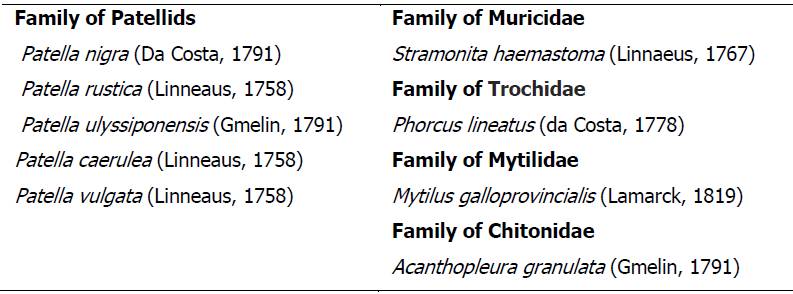
Species richness allowed us to identify 7 species in the station 2 and 3 species in the station 4 (Fig. 2). The station 2 (la montagne) has the highest values with a maximum density of 54 ± 9.53 ind/m2.
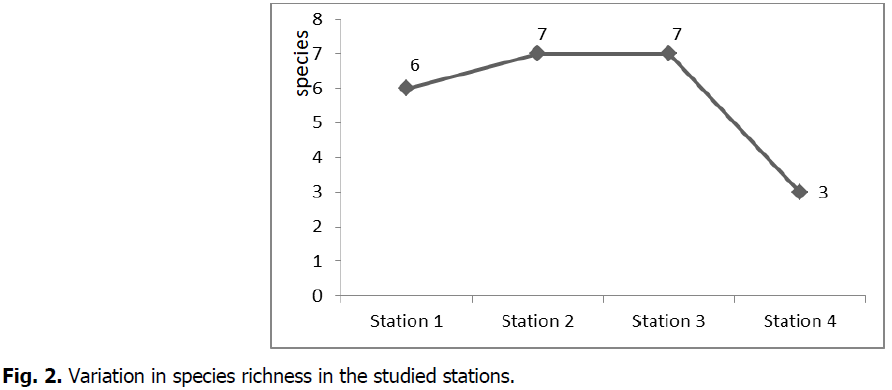
Fig 2: Variation in species richness in the studied stations.
While the lowest density has been found in the station 4 (Boufkirine) 9.33 ± 0.57 ind/m2 (Fig. 3). Density analysis reveals a significant difference between stations, in fact, one-way ANOVA revealed a high significant effect, between the sites during the study period (Table 2).
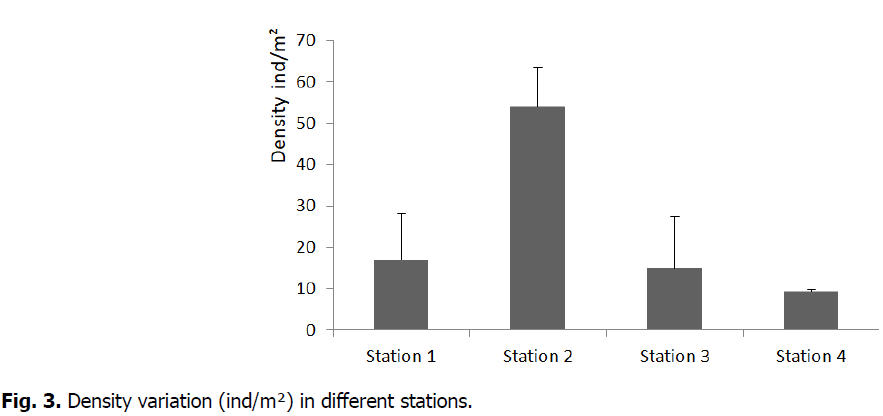
Fig 3: Density variation (ind/m2) in different stations.
| Source | DF | SS | MS | F | P |
|---|---|---|---|---|---|
| Factor | 3 | 415.0 | 138.3 | 3.56 | 0.017** |
| Error | 104 | 4043.6 | 38.9 | ||
| Total | 107 | 4458.6 |
Table 2. One-way ANOVA.
In this study, the index of the diversity of Mollusks ranges from 2.16 in the station 2 and 1.16 in the station 4 (Fig. 4). while evenness index (E) is 0.77 in the station 2 and 0.31 in the station 1.
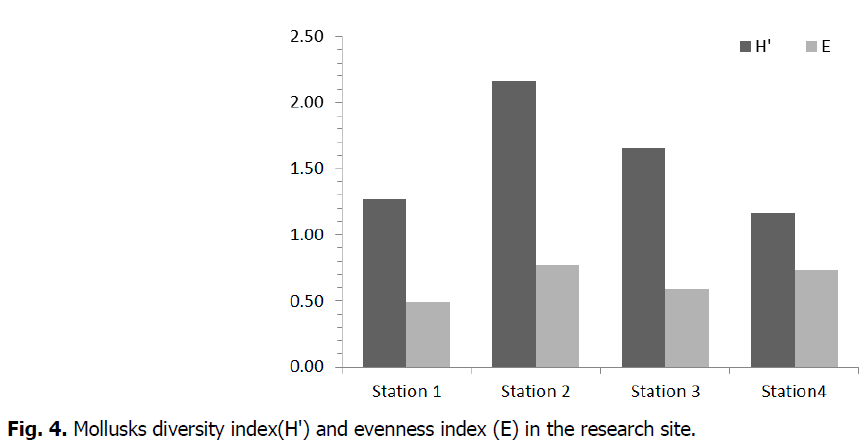
Fig 4: Mollusks diversity index(H') and evenness index (E) in the research site.
The dominance study shows that station 01 (Aouinéte) is dominated by Patella rustica (76.47%) and Patella caerulea (09.80%). While station 02 (La Motagnie) is dominated by Patella rustica (41.36%) followed by the gastropod Stramonita haemastoma (22.84%) and the bivalve Mytilus galloprovincialis (20.99%). The station 03 (La Grande plage) is dominated by Patella ulyssiponensis (62.22%) followed by Phorcus lineatus (22.22%). Patella rustica dominates station 4 (Boufkirine) (57.14%) followed by Acanthopleura granulata with a dominance of (39.29%) (Fig. 5). The leading mollusk in the studied area is the patelidae Patella rustica (74.83%) followed by the gastropod Stramonita haemastoma (26.57%) and the bivalve Mytilus galloprovincialis (23.78%) (Fig. 6).
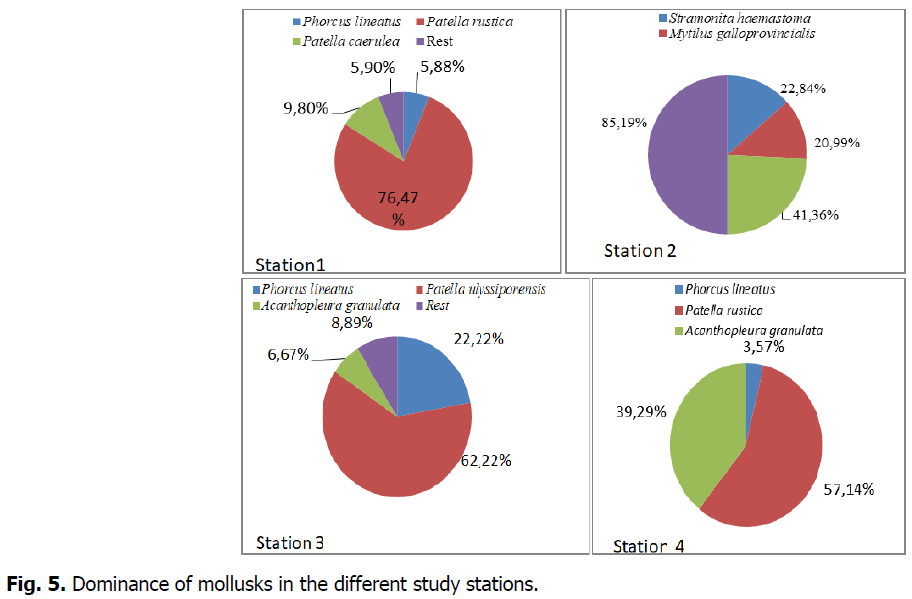
Fig 5: Dominance of mollusks in the different study stations.
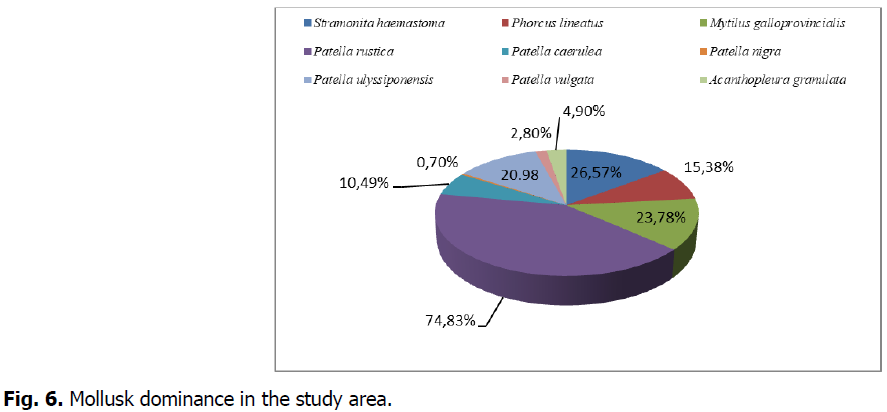
Fig 6: Mollusk dominance in the study area.
Discussion
In the present study, we report 9 species, including 8 Gasteropodes and 1 bivalve. The majority of species encountered in our study are similar to those obtained in the West coast of Algeria by (Meziane et al., 2020). We noted a domination of limpets of the genus Patella compared to the other groups. This situation can be explained by the positioning of the limpets and it's concentration exclusively at the level of the mediolittoral stage as mentioned by (Casal et al., 2018), otherwise, the other groups have a location distributed on several stages.
The index of the diversity and evenness index (E) reveal that the station 2 is more diversified (H'=2,16 and E=0,77). This can be explained by the hydrodynamic action and the marine nutrient reception, moreover, this station reveals that there is no competition between species for the acquisition of space and nutrient source (Capanberg, 2016).
The quantitative study of mollusks shows maximal densities (54 ± 7 ind/m²) in the station 2 (Montagne). This station is characterised by its exposure to the hydronymamic movement, while the other stations show low densities. In fact the station 3 of Boufkirine reveals a minimal density with 9.33 ± 0.57 ind/m2. These fluctuations in density could be explained by the vulnerability of marine mollusks, especially at the level of the mediolittoral stage which offers a restricted habitation zone (Nakin and McQuaid, 2014).
According to (Little et al., 2017), mollusk density decreases with increasing cover. This may confirm the suggestion that faunal density decreases at creeks and in the presence of shelter, as this situation provides refuge for predators.
The distribution areas of mollusks are directly related to all the physico-chemical changes resulting from climate change (Albouy et al., 2013, Devictor et al., 2012, Marzloff et al., 2018, Pecl et al., 2017, Poloczanska et al., 2016, Helmuth et al., 2010, Verdelhos et al., 2015).
The patellidae Patella rustica is the leading mollusk found in our study area because it prefers mediolittoral areas and this is already confirmed by (Lima et al., 2007). Furthermore, (Grimes, 2004) also specify that P. rustica settles mainly in the lower mediolittoral. P. rustica ranges from the Mediterranean to the Atlantic coasts of the Iberianpeninsula and northern Africa, including the Macaronesian Islands (Ridgway et al.,1988; Lima et al., 2006; Sousa et al.,2012).
Conclusion
This study makes a first contribution to the diversity of marine mollusks colonizing the mediolittoral stage of coasts of the El Kala region. The inventory allowed the identification of 9 species, including 8 gastropods and 1 bivalve. In addition, the quantitative study shows spatial variations in the abundance of mollusks in the studied area, indeed when the hydrodynamic action increases we notice the increase in density. In perspective, other complementary studies can be carried out in the field of biomonitoring because mollusks are models of interest for studying the effects of organic and metallic pollutants.
Reference
Albouy, C., Guilhaumon, F., Leprieur, F., Lasram, F.B.R., Somot, S., Aznar, R., Mouillot, D. (2013). Projected climate change and the changing biogeography of coastal Mediterranean fishes. Journal of Biogeography, 40:534-547.
Bouzahouane, H., Barour, C., Sleimi, N., Ouali, K. (2018). Multi-biomarkers approach to the assessment of the southeastern Mediterranean Sea health status: Preliminary study on Stramonita haemastoma used as a bioindicator for metal contamination. Chemosphere, 207:725-741.
Cappenberg, H. (2016). Moluska di Pulau Kabaena, Muna, dan Buton, Sulawesi Tenggara. OLDI (Oseanologi dan Limnologi di Indonesia), 1:61-72.
Casal, G., Aceña-Matarranz, S., Fernández-Márquez, D., Fernández, N. (2018). Distribution and abundance patterns of three coexisting species of Patella (Mollusca Gastropoda) in the intertidal areas of the NW Iberian Peninsula: Implications for management. Fisheries Research, 198:86-98.
Chiavarini, S., Massanisso, P., Nicolai, P., Nobili, C., Morabito, R. (2003). Butyltins concentration levels and imposex occurrence in snails from the Sicilian coasts (Italy). Chemosphere, 50:311-319.
Coll, M., Piroddi, C., Steenbeek, J., Kaschner, K., Ben Rais Lasram, F., Aguzzi, J., Voultsiadou, E. (2010). The biodiversity of the Mediterranean Sea: estimates, patterns, and threats. PloS One, 5:e11842.
Devictor, V., Van Swaay, C., Brereton, T., Brotons, L., Chamberlain, D., Heliölä, J., Jiguet, F. (2012). Differences in the climatic debts of birds and butterflies at a continental scale. Nature Climate Change, 2(2), 121-124.
Fischer, W. (1987). Fiches FAO d'identification des especes pour les besoins de la peche. (Rev 1). Mediterranee et mer Noire. Zone de Peche 37. Vertebres.
El Mortaji, H., Elkhiati, N., Benhra, A., El Haimeur, B., Bouhallaoui, M., Benbrahim, S., Ramdani, M. (2011). Imposex in Stramonita haemastoma (Gastropoda: Muricidae) along the Atlantic and Mediterranean coasts of Morocco. Bulletin de l’Institut Scientifique, Raba, 33:13-18.
Espinosa, F., Guerra-García, J.M., García-Gómez, J.C. (2007). Sewage pollution and extinction risk: an endangered limpet as a bioindicator?. Biodiversity and Conservation, 16:377-397.
Grimes, S. (2004). Le tourisme environnemental et l’ame¬nagement urbain du littoral “Cas de la ville de Jijel”. Thèse de Magister, Université de Constantine, Algeria, p:205.
Grimes, S. (2011). Biodiversité marine en Algérie: Crise des taxonomistes et enjeux de l’activité en réseau. CNDRB. Biodiversité des côtes algériennes. Bulletin du Centre National de Développement des Ressources Biologiques, Numéro spécial. CNDRB, ATE, pp:9-17.
Halpern, B.S., Walbridge, S., Selkoe, K.A., Kappel, C.V., Micheli, F., d'Agrosa, C., Watson, R. (2008). A global map of human impact on marine ecosystems. Science, 319:948-952.
Halpern, B.S., Frazier, M., Potapenko, J., Casey, K.S., Koenig, K., Longo, C., Walbridge, S. (2015). Spatial and temporal changes in cumulative human impacts on the world’s ocean. Nature Communications, 6:1-7.
Helmuth, B., Broitman, B.R., Yamane, L., Gilman, S.E., Mach, K., Mislan, K.A.S., Denny, M.W. (2010). Organismal climatology: analyzing environmental variability at scales relevant to physiological stress. Journal of Experimental Biology, 213:995-1003.
Lemghich, I., Benajiba, M.H. (2007). Survey of imposex in prosobranchs mollusks along the northern Mediterranean coast of Morocco. Ecological Indicators, 7:209-214.
Lima, F.P., Queiroz, N., Ribeiro, P.A., Hawkins, S.J., Santos, A.M. (2006). Recent changes in the distribution of a marine gastropod, Patella rustica Linnaeus, 1758, and their relationship to unusual climatic events. Journal of Biogeography, 33:812-822.
Little, C., Trowbridge, C.D., Pilling, G.M., Stirling, P., Morritt, D., Williams, G.A. (2017). Long-term fluctuations in intertidal communities in an Irish sea-lough: Limpet-fucoid cycles. Estuarine, Coastal and Shelf Science, 196:70-82.
Marzloff, M.P., Oliver, E.C., Barrett, N.S., Holbrook, N.J., James, L., Wotherspoon, S.J., Johnson, C.R. (2018). Differential vulnerability to climate change yields novel deep-reef communities. Nature Climate Change, 8:873-878.
Meziane, K., Kerfouf, A., Baaloudj, A. (2020). Checklist of gastropod molluscs in west coast of Algeria. International Journal of Aquatic Biology, 8:224-227.
Nakin, M.D.V., McQuaid, C.D. (2014). Marine reserve effects on population density and size structure of commonly and rarely exploited limpets in South Africa. African Journal of Marine Science, 36:303-311.
Pecl, G.T., Araújo, M.B., Bell, J.D., Blanchard, J., Bonebrake, T.C., Chen, I.C., Williams, S.E. (2017). Biodiversity redistribution under climate change: Impacts on ecosystems and human well-being. Science, 355:eaai9214.
Poloczanska, E.S., Burrows, M.T., Brown, C.J., García Molinos, J., Halpern, B.S., Hoegh-Guldberg, O., Sydeman, W.J. (2016). Responses of marine organisms to climate change across oceans. Frontiers in Marine Science.
Ridgway, S.A., Reid, D.G., Taylor, J.D., Branch, G.M., Hodgson, A.N. (1998). A cladistic phylogeny of the family Patellidae (Mollusca: Gastropoda). Philosophical Transactions of the Royal Society of London. Series B: Biological Sciences, 353:1645-1671.
Seddik, Y. (2008). Évaluation du niveau de la pollution bactériologique chez un Mollusque Gastéropode Patella caerulea (Linné, 1758) dans la côte oranaise Est. Es Sénia, Oran, Algérie, p:121.
Sousa, L.L., Seabra, R., Wethey, D.S., Xavier, R., Queiroz, N., Zenboudji, S., Lima, F.P. (2012). Fate of a climate-driven colonisation: Demography of newly established populations of the limpet Patella rustica Linnaeus, 1758, in northern Portugal. Journal of Experimental Marine Biology and Ecology, 438:68-75.
Stock, A., Crowder, L.B., Halpern, B.S., Micheli, F. (2018). Uncertainty analysis and robust areas of high and low modeled human impact on the global oceans. Conservation Biology, 32:1368-1379.
Verdelhos, T., Marques, J.C., Anastácio, P. (2015). Behavioral and mortality responses of the bivalves Scrobicularia plana and Cerastoderma edule to temperature, as indicator of climate change's potential impacts. Ecological Indicators, 58:95-103.
Author Info
K. Melouah1*, R. Batah2 and R. Zaidi32Department of Biology, Faculty of Natural and Life Sciences, University of Mohamed Cherif Messadia Souk Ahras, Algeria
3Laboratory of Saharan Ressources, Faculty of Natural and Life Sciences, University of Ahmed Draya, Adrar, Algeria
Citation: Melouah, K., Batah, R., Zaidi, R. (2022). Inventory and distribution of mollusks in the Algerian East coast (El kala region). Ukrainian Journal of Ecology. 12:23-29.
Received: 25-Sep-2022, Manuscript No. UJE-22-75888; , Pre QC No. P-75888; Editor assigned: 27-Sep-2022, Pre QC No. P-75888; Reviewed: 08-Oct-2022, QC No. Q-75888; Revised: 13-Oct-2022, Manuscript No. P-75888; Published: 18-Oct-2022, DOI: 10.15421/2022_400
Copyright: This is an open access article distributed under the terms of the Creative Commons Attribution License, which permits unrestricted use, distribution, and reproduction in any medium, provided the original work is properly cited.

